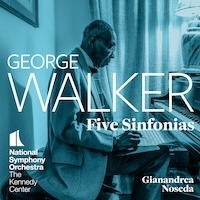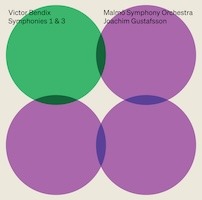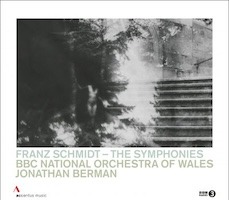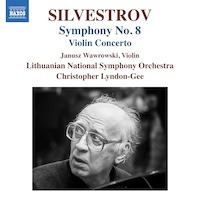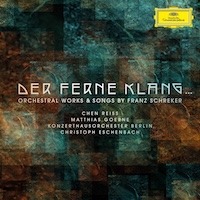Mostly Symphonies 45.
|
Grant Chu Covell [September 2025.]
George WALKER: Sinfonia No. 1 (1984; rev. 1996); Sinfonia No. 2 (1990); Sinfonia No. 3 (2002); Sinfonia No. 4, “Strands” (2011); Sinfonia No. 5, “Visions” (2016)*. Shana Oshiro* (sop), DeMarcus Bolds* (ten), Daniel J. Smith*, V. Savoy McIlwain* (b-bar), Kevin Thompson* (bass). National Symphony Orchestra, Gianandrea Noseda (cond.). NSO 0007 (1 CD) (www.kennedy-center.org). Walker’s Sinfonias put me in mind of Varèse alongside the concision of Schoenberg’s Op. 16. These five Sinfonias are uncompromising, gritty and soaring. There are no niceties, no gratuitous tunes, and repetitions are rare. Perhaps a walking bass appears now and again. Quite unusually for a contemporary composer, Walker does not overuse percussion: Working with motives and harmonies, he avoids flash and effects. Maybe No. 2 offers gentler ideas, but Walker is unfailingly dissonant, stern and granitic. To my ear, these five are remarkably consistent. I suppose Walker calls these Sinfonias because they are not as long as symphonies. Also “sinfonia” is unfamiliar enough so that there are not many contemporary associations (Berio’s effort comes to mind, and I had to double check that Carter spells his “symphonia”). Walker was 62 when he wrote Sinfonia No. 1. The Second seems to be the longest at around 16 minutes. Gathering and releasing extraordinary strength, No. 4, marking Walker’s 90th birthday, is a highpoint. Two spirituals are woven into the work, “There is a Balm in Gilead” and “Roll, Jordan, Roll,” but are difficult to catch. No. 5 includes declaimed texts (excerpts from hymns, Ben Johnson, Stephen Foster, etc.) and stills in Frank Schramm’s optional video chronicle slavery.
Victor BENDIX: Symphony No. 1 in C major, Op. 16, “Ascension” (1877-78); Symphony No. 3 in A minor, Op. 25 (1891-92). Malmö Symphony Orchestra, Joachim Gustafsson (cond.). Dacapo 8.224742 (1 CD) (www.dacapo-records.dk). You didn’t know you were missing this music. In that transitional zone between Wagner and Nielsen, the late-Romantic sweep and coziness of Victor Bendix (1851-1926) will be welcome. But there’s also much that’s bittersweet and forlorn. Lovely No. 1 (1882) suggests Humperdinck’s Overture to Hansel and Gretel (1891-92). There are splashes of Mendelssohn’s fairy music. In three movements with a grotesque Scherzo at its center, No. 3 proceeds with confidence and without No. 1’s innocent charm. Suddenly, Langgaard’s manic Romanticism makes more sense.
“Franz Schmidt – The Symphonies.” Franz SCHMIDT: Symphony No. 1 in E major (1896/99); Symphony No. 2 in E-flat major (1911-13); Symphony No. 3 in A major (1927/28); Symphony No. 4 in C major (1933); Intermezzo and Carnival Music from the opera “Notre Dame” (1903-06). BBC National Orchestra of Wales, Jonathan Berman (cond.). Accentus ACC80544 (4 CDs) (www.accentus.com). In another time, perhaps if this set had appeared in my mailbox (physically or digitally) I would have spent hours with it and emerged with a grand exegesis. However, I’ll have to make do with scattered comments. In short, there is plenty to admire in this release. I came back to this collection after sampling Paavo Järvi’s 2020 cycle for DG (DG 4838336) which contrary to the available criticisms’ summations left me cold and indifferent. Schmidt was a favorite cellist in Mahler’s orchestra, and in Schmidt’s symphonies I hear developments of the atypical buoyant tonal moments in the more famous composer’s Seventh and Eighth, even a continuation of the wandering chorale harmony in the Sixth’s first movement. But Schmidt stands on his own as a concise late Romantic Austro-Germanic composer, not aligned with the atonal Schoenberg school, and more detailed and intricate than opulent Strauss. For example, Schmidt’s symphonic Scherzos are tight, not rambling like Bruckner or Mahler, but terse and harmonically interesting, closer to Haydn in impact and concision. And of course, we must consider Schmidt’s stance during the Second World War. Perhaps he was politically naïve, perhaps he made choices to stay employed and survive. Schmidt’s first wife was institutionalized and then euthanized by the Nazis, and he did not complete a prestigious (obligatory) Third Reich commission, preferring instead to work on pieces for the left-hand pianist Paul Wittgenstein. We must suspect Schmidt had an idea of what was going on around him. The most familiar of Schmidt’s four is the elegiac Fourth written after his daughter’s death, framed with a solo trumpet, packed with energy and emotion. Nos. 3 and 1, in that order, are the symphonies I come back to. The Third won second prize in a symphonic contest meant to evoke Schubert (Atterberg’s Sixth came out on top), and the First possesses exuberance and confidence.
Valentin SILVESTROV: Violin Concerto (2016); Symphony No. 8 (2012-13). Janusz Wawrowski (vln), Lithuanian National Symphony Orchestra, Christopher Lyndon-Gee (cond.). Naxos 8.574481 (1 CD) (www.naxos.com). As concertos go, this one is uncommonly demure, clocking in at 19:35 with four short movements. The orchestra supports but does not overwhelm; the violin leads but does not posture or grandstand. Stylistically we hear tonal fragments, sometimes harmonized sympathetically, at other times supported with dissonance. Here is a concerto of aftereffects, the soloist wandering casually through a faded landscape. There are frissons that fade, and sweet tunes that arrive at dead ends. By the final bars, the meek inherit the earth. Let’s not forget that the violinist must work hard to make it seem so simple. Symphony No. 8 exists in the similar limbo first spied in Symphony No. 4 and thereafter. Any sympathetic description will read like bad poetry: Imagine curtains peeling back to reveal the partially forgotten and not yet remembered. Imagine colorful weeds growing in abandoned lots. There are few striking themes despite the fanfares. Frail but determined passages are built on diminished seventh chords. The symphony is a series of moods, chords and outlines. Eventually a piano offers a sentimental tune which the strings repeat. In 2021, I was disappointed by Silvestrov’s Seventh. Having deeply considered No. 5, I have a better sense of what Silvestrov might be saying. Perhaps I’m more sympathetic to Silvestrov these days but No. 8 is decidedly more substantial than No. 7. If you’re already a fan, this is essential. If you’re unfamiliar, then this might take some getting used to. A phrase I associate with an entirely different composer (Nono) feels apt here: Nostalgia for the future.
“Der Ferne Klang…” Franz SCHREKER: Nachtstück from Der ferne Klang (1903-10); Valse lente (1908); Kammersymphonie (1916); Vom ewigen Leben (1923/27)*; Fünf Gesänge (1909/22)**; Kleine Suite (1928); Romantische Suite, Op. 14 (1903). Chen Reiss* (sop), Matthias Goerne** (bar), Konzerthausorchester Berlin, Christoph Eschenbach (cond.). DG 486 3990 (2 CDs) (www.deutschegrammophon.com). If the Nazi’s rise to power hadn’t wrecked Schreker’s career, our understanding of early 20th century German opera would be fuller. This two-disc set hides remarkable moments: Nachtstück encapsulating the atmosphere from the opera Der ferne Klang (dedicated to Bruno Walter, its vocal score was arranged by Berg), passionate sequences in Valse lente that could be mistaken for Puccini, the luscious Op. 8 Intermezzo which found its way into the Romantic Suite, etc. The Chamber Symphony suggests Mahler filtered through Schoenberg with exotic touches. Zemlinsky’s 1934 Sinfonietta would be a younger, soberer cousin. This collection presents two orchestral song collections: A pair of Whitman texts in Vom ewigen Leben with soprano, and four songs of Edith Ronsperger prefixed with words from the Arabian Nights for baritone. Altogether, such lovely slush, these song cycles and almost-symphonies, suggesting happier days when a toe could be dipped without commitment into atonality.
[More Grant Chu Covell, Mostly Symphonies]
[Previous Article:
Used Bin Troll Tweets XXX.]
[Next Article:
Used Bin Troll Tweets YYY.]
|
